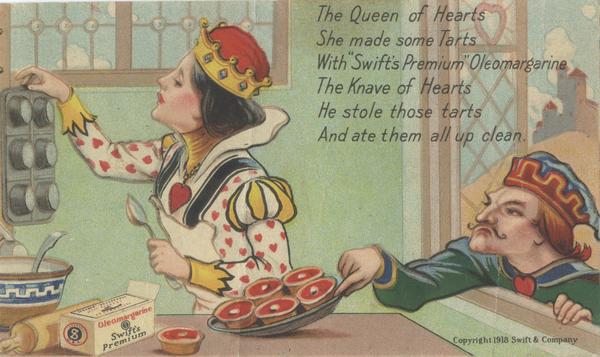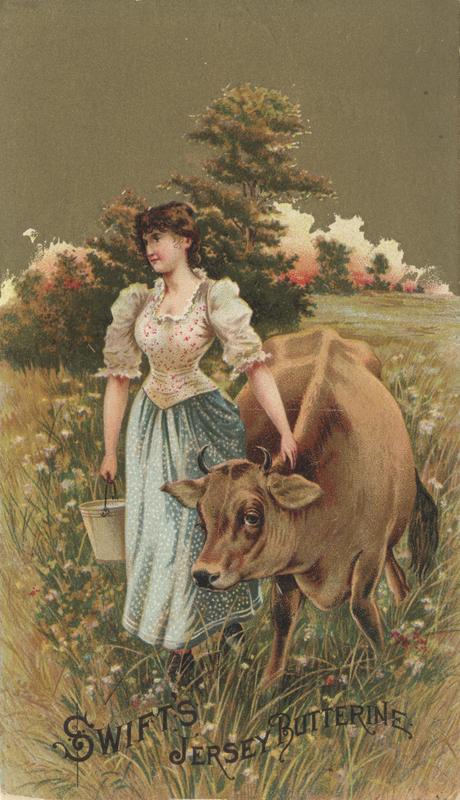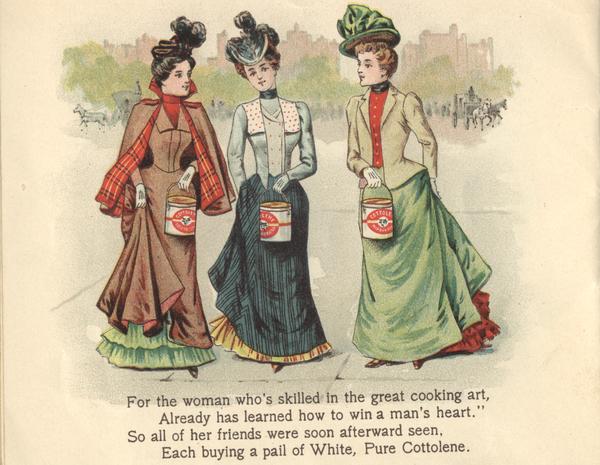Hagley Library’s collections are rich in food history, from the business of food production and consumption to advertising and packaging to American foodways and the social, cultural, and technical aspects of food preparation. One type of gustatory documentation consists of the bits and bobs of paper that are often thrown away—trade cards, menus, labels, packaging, wrappers, recipe booklets—or what food historians call culinary ephemera. Even though these items were never meant to last, the ones that survive provide us with a very real window into the intimate details of the day-to-day past.
One product familiar to many of us who grew up in the United States is the butter substitute margarine. In 1869, responding to a national butter shortage, French chemist Hippolyte Mège-Mouriès (1817-1880) developed an alternative spread from beef tallow, patenting the product in several countries as oleomargarine. Although he was awarded a prize for his efforts from Emperor Napoleon III and his product was used by the French Navy, oleomargarine never really caught on in Mège-Mouriès’ home country. Its production was ultimately picked up by the Dutch company Jurgens, now part of Unilever.

Margarine consumption in Great Britain and America accelerated during the early twentieth century, with the meatpacking operation Swift & Company featuring heavily in surviving advertising from this period. Above, see a Swift’s advertising postcard featuring a whimsical take on Lewis Carroll’s Alice in Wonderland.
 Another product from this period, Butterine, promised a wholesome butter substitute; advertising materials emphasized its purity and similarity to the dairy version, claiming Butterine was "made of exactly what composes natural Butter, namely, the choicest Butter-producing Animal Oils, compounded in a churn.” This trade card, also from Swift’s, really plays up this imagery, layering it on thick with an angelic country milkmaid and her sleepy-eyed cow and the slogan on the back, “Sweet – Pure – Clean, buy Swift’s Jersey Butterine.”
Another product from this period, Butterine, promised a wholesome butter substitute; advertising materials emphasized its purity and similarity to the dairy version, claiming Butterine was "made of exactly what composes natural Butter, namely, the choicest Butter-producing Animal Oils, compounded in a churn.” This trade card, also from Swift’s, really plays up this imagery, layering it on thick with an angelic country milkmaid and her sleepy-eyed cow and the slogan on the back, “Sweet – Pure – Clean, buy Swift’s Jersey Butterine.”
Butterine, however, was not butter! The dairy industry fought back hard against butter alternatives. It took on the meatpackers, contesting the practice of dying oleomargarine and Butterine yellow to look more like dairy butter, and ultimately seeing the passage of the 1886 Butter Act, the only food standard ever passed by Congress. It set a precedent, too, for food regulation by the federal government, expressed in the 1906 Pure Food and Drug Act—following Upton Sinclair’s exposé novel, The Jungle, about unsanitary conditions and worker abuse in meatpacking plants—and, eventually, the creation of the Food and Drug Administration.
Moving into the baking realm, Cottolene was shortening (Crisco is a more familiar name today), made from beef suet and cottonseed oil, and marketed to replace lard. Cottolene was advertised by the N.K. Fairbank Company on a national scale with the somewhat dubious slogan, “shortens your food, lengthens your life.”
 In this promotional giveaway booklet we get the detailed story—in verse and across four illustrated spreads in punchy colors!—of the fair and a virtuous maiden, in search of wholesome and pure foods, who goes to the market, receives a booklet (just like this one!) with her Cottolene purchase, goes home to bake up some fantastic pies, wins the heart a man who is so bowled over by the quality of her baking that he proposes on the spot, and becomes the envy of all her friends. Fortunately, she’s willing to share her secret, and soon all the fair maidens are sporting pails of Cottolene. In-between, the booklet offers instructions for using Cottolene in baking and frying, recipes, and testimonials.
In this promotional giveaway booklet we get the detailed story—in verse and across four illustrated spreads in punchy colors!—of the fair and a virtuous maiden, in search of wholesome and pure foods, who goes to the market, receives a booklet (just like this one!) with her Cottolene purchase, goes home to bake up some fantastic pies, wins the heart a man who is so bowled over by the quality of her baking that he proposes on the spot, and becomes the envy of all her friends. Fortunately, she’s willing to share her secret, and soon all the fair maidens are sporting pails of Cottolene. In-between, the booklet offers instructions for using Cottolene in baking and frying, recipes, and testimonials.
Today’s non-dairy butter products, it should be noted, no longer follow the original oleomargarine, Butterine, or Cottolene recipes. So no matter what you spread on your bread, enjoy!
Learn more in Hagley’s Digital Archives by perusing the Carter Litchfield history of fatty materials collection.
Diane E. Bockrath is an Archivist at Hagley Museum and Library
